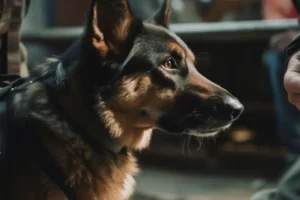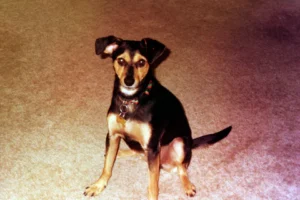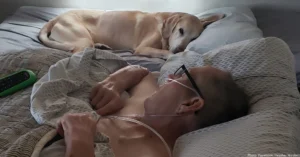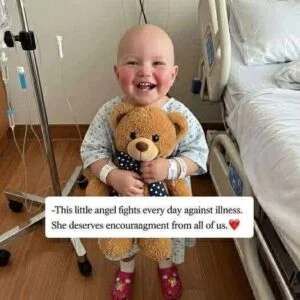
The Silent Witness
Chapter 1: The Weight of Silence
That morning, the courthouse did not feel like a building of stone and wood. It felt like a living creature — its walls exhaling the stale breath of forgotten trials, its windows straining against the weight of secrets pressing to escape.
Every bench creaked under the restless shuffling of bodies, but beneath the noise there pulsed a silence, taut and trembling, like a violin string about to snap
At the very front sat a little girl, so small that the bench seemed to swallow her. Her legs swung back and forth, the polished tips of her shoes never once grazing the floor.
She clutched against her chest a stuffed bear whose threadbare body betrayed years of devotion. Its seams gaped, its single surviving button eye reflected the faint light like a tear unwilling to fall.
The child’s yellow dress, neatly pressed, glowed softly in the morning sunlight that slipped through the tall windows. And in her hair, a pink ribbon tied into a bow shimmered faintly, catching every glimmer of light and transforming her into an image of fragile innocence, utterly dissonant with the severity of the courtroom.
People glanced at her curiously now and then, though their attention always drifted back to the proceedings. They knew her story, whispered in hushed tones outside the courthouse doors. Emma Claire Morrison, age six. The sole survivor of the Morrison family tragedy that had gripped the city for eighteen months.
Dr. Sarah Chen, the court-appointed child psychologist sitting beside Emma, observed the girl with professional concern masked as maternal protectiveness. For eight months, Sarah had worked with Emma, trying to unlock the memories sealed behind trauma’s vault. The child had not spoken a single word about that terrible night, communicating only through drawings of stick figures and dark scribbles that revealed nothing and everything at once.
“She’s too young to testify,” the defense attorney had argued repeatedly. “A six-year-old cannot be considered a reliable witness, especially one suffering from severe psychological trauma.”
But the prosecution had persisted. “Your Honor, Emma Claire Morrison is the only surviving witness to the murders of her parents and older brother. While we understand the difficulties involved, justice for the Morrison family may depend on what she witnessed.”
The judge, Honorable Patricia Hawthorne, had wrestled with the decision for weeks. Twenty-seven years on the bench had taught her to balance legal precedent with human compassion, but this case stretched both to their limits. In the end, she had ruled that Emma could be present during the proceedings, though whether she would or could testify remained an open question.
Now, as the trial entered its third day, Emma sat like a small statue, her presence both vital and heartbreaking. She had not spoken, had barely moved, had shown no recognition of the defendant who sat thirty feet away in an orange jumpsuit, his hands folded in calculated contrition.
Marcus Webb, thirty-four, a former neighbor of the Morrison family. A man with a history of break-ins, escalating violence, and an obsession with Linda Morrison that had manifested in increasingly disturbing ways. The prosecution painted him as a predator who had stalked the family for months before breaking into their home on that October night. The defense claimed he was a convenient scapegoat, a troubled man whose past made him an easy target for a police force desperate to close a high-profile case.
Chapter 2: The Evidence Unfolds
The morning had been spent reviewing forensic evidence that painted a picture of calculated brutality. DNA evidence linking Webb to the crime scene. Fingerprints on the window he had allegedly used to enter the house. Blood evidence that told a story of systematic violence that had left David Morrison, Linda Morrison, and their eight-year-old son Michael dead in their own home.
Detective Ray Alvarez, the lead investigator, had testified with the weary authority of a man who had seen too much violence in his twenty-year career. “The perpetrator entered through the kitchen window sometime after midnight,” he explained to the jury, his voice steady despite the horrific images projected on the courtroom screen. “He moved through the house methodically, attacking each family member in turn. Based on the evidence, we believe Emma was hiding in her bedroom closet during the attacks.”
The crime scene photos were graphic enough that Judge Hawthorne had cleared the gallery of spectators, leaving only the essential participants to witness the documentation of the Morrison family’s final moments. Emma had been led from the courtroom during this portion of the testimony, sparing her the sight of images that would have traumatized even hardened adults.
But now she was back, sitting beside Dr. Chen, her small form a constant reminder of the human cost of the violence being dissected with clinical precision.
The prosecution’s case seemed airtight. Webb had no credible alibi for the night of October 15th. His fingerprints were found at the crime scene. His DNA was recovered from blood evidence. Multiple witnesses testified to his obsessive behavior toward Linda Morrison, including unwanted visits to her workplace and gifts left on the family’s doorstep despite repeated requests to leave them alone.
“Marcus Webb was fixated on Linda Morrison,” Assistant District Attorney Jennifer Walsh had told the jury during opening statements. “When she rejected his advances and her husband threatened legal action, his obsession turned deadly. On October 15th, he broke into their home with the intention of taking what he believed belonged to him. When the family resisted, he killed them all. Only Emma survived because she was small enough to hide where he couldn’t find her.”
The defense, led by veteran attorney Robert Castellanos, had struggled against the weight of physical evidence. Their strategy focused on challenging the investigation’s methodology and suggesting that Webb was being railroaded by a police force under public pressure to solve a case that had horrified the community.
“My client is a troubled man,” Castellanos had admitted. “He’s made mistakes, and his behavior toward the Morrison family was inappropriate and troubling. But inappropriate behavior is not murder. The police needed a suspect, and Marcus Webb fit their profile. They built their case around making the evidence fit their theory, not following the evidence wherever it led.”
Chapter 3: The Unexpected Evidence
It was during the third day of testimony that the prosecution introduced what they called their “final piece of evidence.” Detective Alvarez returned to the witness stand, his expression more solemn than usual.
“Detective, please tell the court about the additional evidence recovered from the Morrison crime scene,” ADA Walsh requested.
Alvarez nodded toward the back of the courtroom, where a uniformed officer waited with a leash. “During our investigation, we discovered that a dog had been present at the Morrison residence on the night of the murders. The animal was found three days later by animal control, hiding in the woods approximately two miles from the Morrison home.”
The courtroom stirred with interest as the officer led a medium-sized golden retriever into the space. The dog moved calmly, its coat gleaming despite the obvious stress of being in an unfamiliar environment.
“This is Buddy, the Morrison family dog,” Alvarez continued. “He was approximately two years old at the time of the murders and had been living with the family since he was a puppy. Forensic analysis revealed that Buddy had blood on his fur that matched both the victims and the perpetrator.”
Emma, who had remained motionless throughout the morning’s testimony, suddenly became alert. Her grip on the stuffed bear tightened, and Dr. Chen noticed the child’s breathing quicken.
“The significance of this evidence,” Alvarez explained, “is that Buddy appears to have witnessed the murders and may have attempted to protect the family. The blood evidence suggests he bit the perpetrator during the attack.”
Defense attorney Castellanos objected immediately. “Your Honor, this is highly prejudicial. A dog cannot testify, and any assumptions about the animal’s behavior are pure speculation.”
“The evidence is relevant to establishing the timeline and nature of the attack,” ADA Walsh countered. “The dog’s presence provides additional context for understanding what occurred that night.”
Judge Hawthorne considered for a moment. “I’ll allow the evidence, but the jury is instructed to consider only the physical evidence associated with the animal, not speculation about its behavior or thoughts.”
Chapter 4: Recognition
The dog, sensing the gravity of the moment despite not understanding its role in human justice, had settled quietly beside its handler. Buddy’s dark eyes scanned the courtroom with the alertness of an animal accustomed to reading human emotions and intentions.
It was then that the extraordinary happened.
The little girl raised her hand.
At first, no one noticed. Her small fingers trembled slightly, suspended in the heavy air. Then her arm stretched forward with the certainty of instinct. She pointed directly at the dog.
The animal, seemingly ordinary creature brought in as evidence, had been resting on its haunches beside the handler, calm and unnoticed.
But in that instant, the girl’s gesture drew every eye toward it. A ripple went through the room, an invisible wave that left goosebumps in its wake.
The silence deepened, shifting from passive stillness into something electric, charged with meaning. The child’s voice, when it finally came, was soft yet searing:
“That’s him.”
Three words, barely audible, yet they struck like thunder. Gasps broke through the crowd. Judge Hawthorne’s composure cracked, her brows furrowing in confusion and concern.
The handler instinctively tightened the leash, though Buddy had not moved. Lawyers abandoned their scripts, blinking as though the ground beneath them had tilted.
But the girl did not waver. Her wide eyes, shimmering with unshed tears, stayed fixed on the animal. Her tiny chest rose and fell in uneven breaths, but her finger remained steady, unyielding. She was not pointing in fear. She was pointing in recognition.
Dr. Chen leaned forward, her professional training warring with maternal instinct. “Emma? What do you mean, sweetheart?”
The child’s voice came again, stronger now, carrying the weight of months of silence finally broken: “That’s Buddy. He saved me.”
Chapter 5: The Flood of Memory
The words seemed to unlock something deep within Emma’s traumatized mind. Dr. Chen had warned the court that memory recovery in young trauma victims was unpredictable, often triggered by sensory experiences that connected to the original event.
“Buddy protected me,” Emma continued, her voice gaining strength as dormant memories surfaced. “When the bad man came, Buddy barked and barked. He bit the man’s arm when he tried to come in my room.”
The courtroom remained frozen as the six-year-old survivor finally began to speak about the night that had destroyed her family. Judge Hawthorne leaned forward, her judicial demeanor softening as she witnessed the courage of a child confronting her worst memories.
“Emma,” Dr. Chen said gently, “can you tell us what you remember about that night?”
The little girl looked around the courtroom, her eyes eventually settling on the defendant. For the first time since the trial began, she made direct eye contact with Marcus Webb.
“I was sleeping,” she said, her voice clear despite the tears beginning to flow down her cheeks. “Buddy was sleeping on my bed. Then we heard scary noises downstairs. Buddy got up and started growling.”
ADA Walsh approached slowly, her prosecutor’s instincts warring with her recognition that she was dealing with a deeply traumatized child. “Emma, you don’t have to be afraid. Can you tell us what happened next?”
“Mommy screamed,” Emma continued, her grip on the stuffed bear tightening until her knuckles went white. “Daddy yelled at someone to get out. Buddy ran downstairs, but then he came back real fast and pushed me toward my closet.”
The courtroom hung on every word as the child’s memories poured forth like water through a broken dam.
“I hid in my closet like Daddy taught me. Buddy stayed with me, but he was scared too. He was shaking.” Emma’s voice began to waver as the memories became more vivid. “The bad man came upstairs. I could hear his footsteps. Heavy footsteps.”
Dr. Chen placed a reassuring hand on Emma’s shoulder. “You’re being very brave, Emma. Take your time.”
“Buddy heard him coming to my room,” Emma continued. “When the man opened my door, Buddy ran out and bit him really hard. The man yelled bad words and hit Buddy with something heavy. I heard Buddy crying.”
Marcus Webb had gone completely pale, his hands trembling as he listened to the child’s account. His attorney leaned over to whisper urgently in his ear, but Webb seemed incapable of responding.
“What happened after that, Emma?” ADA Walsh asked gently.
“The man looked for me, but Buddy had pushed me way back in the closet behind my clothes. The man was bleeding on his arm where Buddy bit him. He looked and looked, but then he heard sirens far away and he ran.”
The silence in the courtroom was absolute as Emma’s testimony revealed details that had never emerged in the eighteen months since the murders.
“Buddy was hurt bad,” Emma continued, tears flowing freely now. “He crawled into the closet with me and we stayed there all night. He was bleeding and crying, but he wouldn’t leave me. Even when the police came, he wouldn’t let anyone near me until Officer Martinez gave him a treat and showed him it was safe.”
Chapter 6: The Defense Crumbles
Defense attorney Castellanos was frantically shuffling through his papers, clearly unprepared for testimony that corroborated every element of the prosecution’s case while adding new details that his client had never mentioned.
“Your Honor,” Castellanos said, rising on unsteady legs, “I request a brief recess to confer with my client.”
“Motion denied,” Judge Hawthorne replied firmly. “Emma is testifying now, and I will not interrupt her while she’s finding her courage. Continue, sweetheart.”
Emma looked directly at Marcus Webb again, her child’s gaze holding a clarity that was devastating in its innocence. “Why did you hurt my family?” she asked simply.
Webb’s composure finally shattered completely. “I didn’t mean for it to happen like that,” he said, his voice breaking. “I just wanted to talk to your mother. I loved her. She didn’t understand how much I loved her.”
Castellanos grabbed his client’s arm, trying to stop him from continuing, but Webb seemed compelled to explain himself to the small girl whose family he had destroyed.
“When your father threatened me, told me to stay away, I got angry. I just wanted Linda to see that she belonged with me, not with him. But when I got in the house, everything went wrong. Your father fought me, and your brother tried to help him, and your mother started screaming…”
“Mr. Webb!” Castellanos shouted, finally breaking through his client’s confession. “Do not say another word!”
But it was too late. Webb’s admission had been heard by everyone in the courtroom, recorded by the court reporter, and witnessed by the jury that would decide his fate.
Emma continued to stare at him with those enormous, hurt-filled eyes. “Buddy tried to protect us,” she said simply. “You hurt him too.”
Chapter 7: The Reunion
ADA Walsh realized that Emma’s breakthrough testimony had essentially concluded her case, but something more important than legal strategy was happening in the courtroom. A traumatized child was finally confronting the man who had destroyed her world, and she was doing it with the courage that only innocence could provide.
“Emma,” Walsh said gently, “would you like to see Buddy again?”
The child nodded eagerly, tears still streaming down her face. The handler, understanding the therapeutic importance of the moment, slowly guided Buddy toward the front of the courtroom.
The dog had been listening to Emma’s voice with increasing alertness, his tail beginning to wag as recognition dawned. As he approached the bench where Emma sat, his entire body began to tremble with excitement and emotion.
“Buddy!” Emma cried, sliding down from the bench and running toward the dog despite Dr. Chen’s attempts to maintain courtroom protocol.
The reunion was immediate and overwhelming. Buddy, despite his training and the formal setting, could not contain his joy at being reunited with the child he had protected. He licked her face enthusiastically while she buried her small hands in his golden fur, sobbing with relief and happiness.
“I missed you so much,” Emma whispered into Buddy’s fur. “I thought you were dead. I thought the bad man killed you too.”
Dr. Chen approached cautiously, her professional objectivity overwhelmed by the emotional significance of what she was witnessing. In all her years of working with traumatized children, she had never seen such an immediate and powerful breakthrough.
Judge Hawthorne made no attempt to restore order, recognizing that what was happening transcended legal procedure. The jury watched with tears in their eyes as the child and dog clung to each other, two survivors of unimaginable trauma finding healing in their reunion.
Even Marcus Webb was sobbing openly, the full weight of what he had done finally breaking through his self-protective delusions. He had not just destroyed a family—he had traumatized a child and separated her from the loyal companion who had risked his life to protect her.
Chapter 8: The Healing
The trial concluded that afternoon with Marcus Webb entering a plea of guilty to three counts of first-degree murder. The confession Emma had unknowingly extracted from him eliminated any possibility of continuing his defense.
But more importantly for Emma, she had finally spoken about the night that had haunted her dreams for eighteen months. The presence of Buddy, her protector and friend, had unlocked memories that no amount of therapy had been able to reach.
“Animals often serve as emotional bridges for traumatized children,” Dr. Chen explained to the media after the trial. “Buddy represented safety and protection for Emma. Seeing him again allowed her to access memories that were too painful to confront without that sense of security.”
Emma was reunited with Buddy permanently that day. Her grandmother, who had been caring for her since the murders, had been told the dog was too traumatized to be a suitable pet for a grieving child. Instead, animal control had placed Buddy with a foster family while he recovered from his own physical and emotional wounds.
The foster family, the Hendersons, had cared for Buddy lovingly but always knew he belonged somewhere else. When they learned about his heroic actions and his bond with Emma, they insisted on facilitating the reunion.
“He was never really ours,” Mrs. Henderson said, watching Emma and Buddy play in her backyard after the trial. “He was always waiting for her. He would sit by the window every day, watching for something we couldn’t see. Now we know what he was waiting for.”
Chapter 9: Justice and Recovery
Marcus Webb was sentenced to life in prison without the possibility of parole. The judge’s sentencing statement was brief but pointed: “You not only took three innocent lives, Mr. Webb, but you traumatized a child and separated her from the animal companion who tried to protect her family. Your actions represent a level of selfishness and violence that society cannot tolerate.”
Emma’s recovery was gradual but steady. With Buddy by her side and Dr. Chen’s continued therapy, she slowly began to process her trauma and rebuild her capacity for trust and joy. The dog, who had suffered his own psychological wounds, seemed to heal alongside her.
“They’re healing each other,” Dr. Chen observed during one of their sessions. “Emma is learning to feel safe again, and Buddy is learning that he did his job well. He protected her when it mattered most.”
The case became a landmark in discussions about child testimony, animal-assisted therapy, and the bonds between humans and their companion animals. Legal scholars debated the precedent set by allowing a dog’s presence to facilitate crucial testimony, while psychologists studied the therapeutic benefits of reuniting trauma survivors with their animal companions.
But for Emma, the academic discussions were irrelevant. What mattered was that she had her friend back, the friend who had stayed with her through the darkest night of her life and who would continue to stay with her as she grew up and learned to trust the world again.
Chapter 10: The Silent Strength
A year later, Emma Morrison stood in the same courthouse, but this time for a victim impact statement at Marcus Webb’s appeal hearing. She was seven now, taller and more confident, but still small enough that her feet didn’t quite touch the floor when she sat on the witness bench.
Buddy sat beside her, wearing a specially designed service dog vest that identified him as Emma’s emotional support animal. The dog that had once been evidence in a murder trial was now officially recognized as a therapeutic companion, trained to detect Emma’s anxiety and provide comfort during difficult moments.
“I want to tell the court about my family,” Emma said, her voice clear and steady in a way that would have been impossible a year earlier. “My daddy taught me to ride a bike and helped me with my homework. My mommy sang to me every night before bed. My brother Michael shared his toys with me even when I broke them.”
She paused, one hand resting on Buddy’s head, drawing strength from his presence.
“They were good people who loved each other and loved me. Mr. Webb took them away because he wanted something that wasn’t his to take. But he didn’t take everything. He didn’t take Buddy, and he didn’t take my memories of how much my family loved me.”
The appellate judges listened with the gravity that Emma’s words deserved. Webb’s appeal was based on claims of inadequate legal representation, but no one in the courtroom that day doubted the justice of his conviction.
“Buddy taught me that even when bad things happen, there are still good things worth protecting,” Emma continued. “He protected me that night, and now he helps me feel safe every day. I’m not scared anymore, because I know that love is stronger than the bad things people do.”
Epilogue: The Enduring Bond
Five years after the trial that shocked a community and changed legal precedent, Emma Morrison graduated from elementary school as valedictorian of her sixth-grade class. Buddy, now grayer around the muzzle but still devoted, sat in the front row of the auditorium next to Emma’s grandmother and Dr. Chen, who had become like a second mother to the girl.
Emma’s graduation speech was about resilience, healing, and the unexpected heroes who help us through our darkest moments. She spoke about family, both the one she had lost and the one she had found in the people and animals who had supported her recovery.
“Sometimes terrible things happen that we can’t understand or prevent,” she told her classmates and their families. “But we get to choose what we do after the terrible things. We can choose to let them make us smaller and more afraid, or we can choose to let them teach us how strong we really are.”
As she spoke, Buddy’s tail wagged slowly, proudly, as if he understood that the small girl he had protected that terrible night had grown into someone remarkable. The bond between them had not only survived trauma but had become a source of strength that would carry them both forward into whatever challenges life might bring.
In the audience, Dr. Chen wiped away tears as she watched her young patient demonstrate the kind of courage and wisdom that came from facing the worst of human nature and choosing to believe in the best. The child who had once been too traumatized to speak had become a voice for healing, forgiveness, and the enduring power of love to overcome even the deepest wounds.
The courtroom where it all began still stood in the center of the city, still hosting trials and dispensing justice. But for those who remembered that day when a little girl pointed at a dog and said “That’s him,” the building would always represent something more—a place where truth emerged from silence, where courage conquered fear, and where the bond between a child and her protector proved stronger than the evil that had tried to destroy them both.
Emma and Buddy walked home together that day, as they did every day, two survivors who had found healing in each other’s presence and who would continue to face the future side by side, living proof that even in the darkest moments, love endures and heroes come in many forms.









